Socks for hiking
Hiking practice
Socks are socks aren’t they? Any old pair will do? This is the way many people think about their sock choices and when they head out for a hike, they grab whatever is in the drawer. I’m the exact opposite spending more time than most carefully considering my choices. I’ve tested well over 30 different models of socks since starting Australian Hiker in 2016 and many more prior to that. From my perspective, socks are an important part of my footwear system and shouldn’t be chosen in isolation. Instead, socks need to be considered in conjunction with the shoes/boots, environmental conditions and personal preferences.
Putting a degree of thought into your sock choice you will ensure a more comfortable and less problematic hike but with literally hundreds of brands and models on the market, how do you choose the right one for you? Considerations such as material, cushioning, fit, height, weight and even colour/pattern are all something that come into play. But what impact do each of them have and how can they affect your choice? In this article we talk everything socks to help you choose the ones that suit your individual needs.
Fit
As with any piece of clothing your socks need to fit comfortably. Using the wrong size socks, using socks that are just uncomfortable or buying socks just because they’re cheap is false economy. One thing you need to be aware of is that sock sizes vary. As someone with a size 15US foot I will typically choose either a ‘large’ or a 11-15 sizing. However its rare I will choose an XL sizing often finding the length too long which surprises me.
If your socks are too large then they will tend to bunch up and this becomes uncomfortable and can cause blisters. Socks that are t0o small will typically work but won’t last very long and will squish your feet. A sock fits properly when the heel cup lines up with the heel of your foot and your toes aren’t jammed together.
The socks and footwear you choose will either make or break a hike so put some thought into ensuring they are comfortable first and foremost.
Sock height
Socks, including hiking socks come in different heights. In choosing a sock height there are two main criteria. Firstly you want the sock to be high enough to be above the height of your footwear so that the top of your footwear doesn’t rub on your leg or your shoes don’t ‘eat’ your socks.
Secondly the higher the sock the greater the warmth (not always) that they will typically have. This can be a good or a bad thing as you want a sock that will keep you warm enough at particular times of the year so this may mean you need to change your sock choices over the different seasons.
Socks come in differing heights and depending on the manufacturer you will come across different terms used to describe them. Typically the higher the sock the thicker and warmer it is but this isn’t always the case. Many manufacturers will use the following terms to describe the height of socks from lowest to highest:
-
- As the name indicates this sock is almost invisible when on but aren’t a common hiking sock as they are typically a running or dress sock
-
- This height of sock will come just above the top of trail running shoes but only just. Again not a common hiking sock and a height typically used for running
-
- This sock height is one of the most common heights for hikers and usually sits above the ankle. Typically 1/4 height socks are used for warmer weather and will provide enough protection for your ankles without being too hot
-
- Higher than 1/4 socks usually coming half way up the calf. These socks are typically used for extra warmth
-
- These socks sit about 3/4 of the way up the calf and are often considered winter socks
-
- Which sit just below the knee and are typically a winter sock that provides lots of warmth. Not as common as they used to be!
Other terms used to describe sock heights are:
- Mini crew
- Crew
- Knee-high
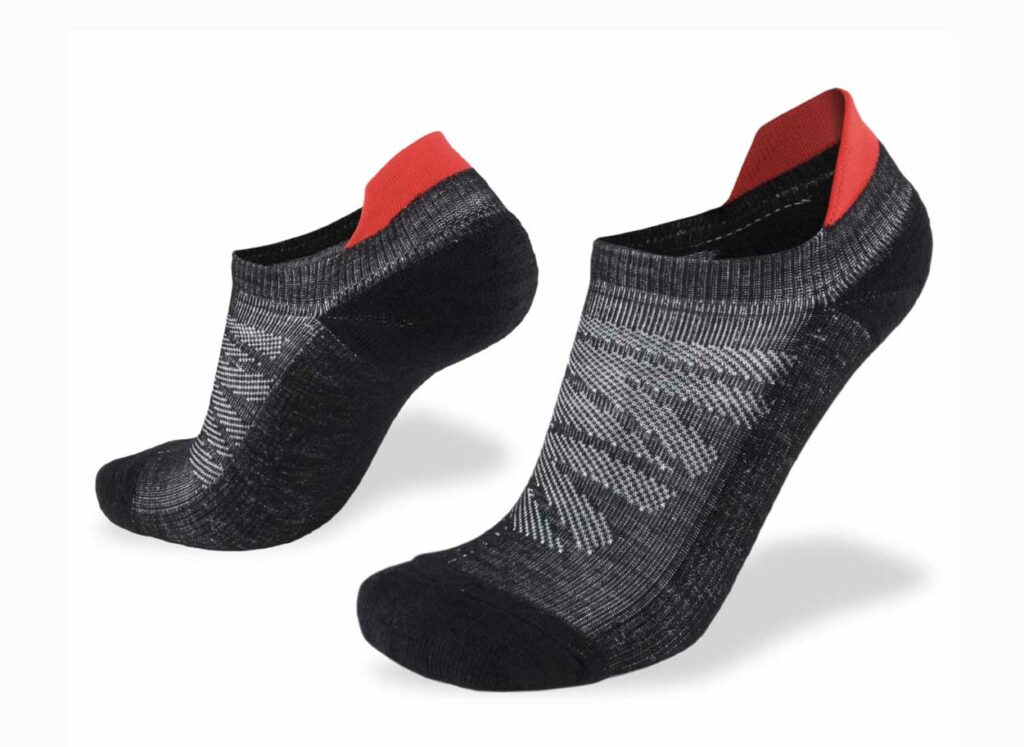
Wilderness Wear Men’s Merino 10k No Show Tab Socks

Wilderness Wear 10km socks – Low height

Wilderness Wear Multisport 4.0 Sock – 1/4 height
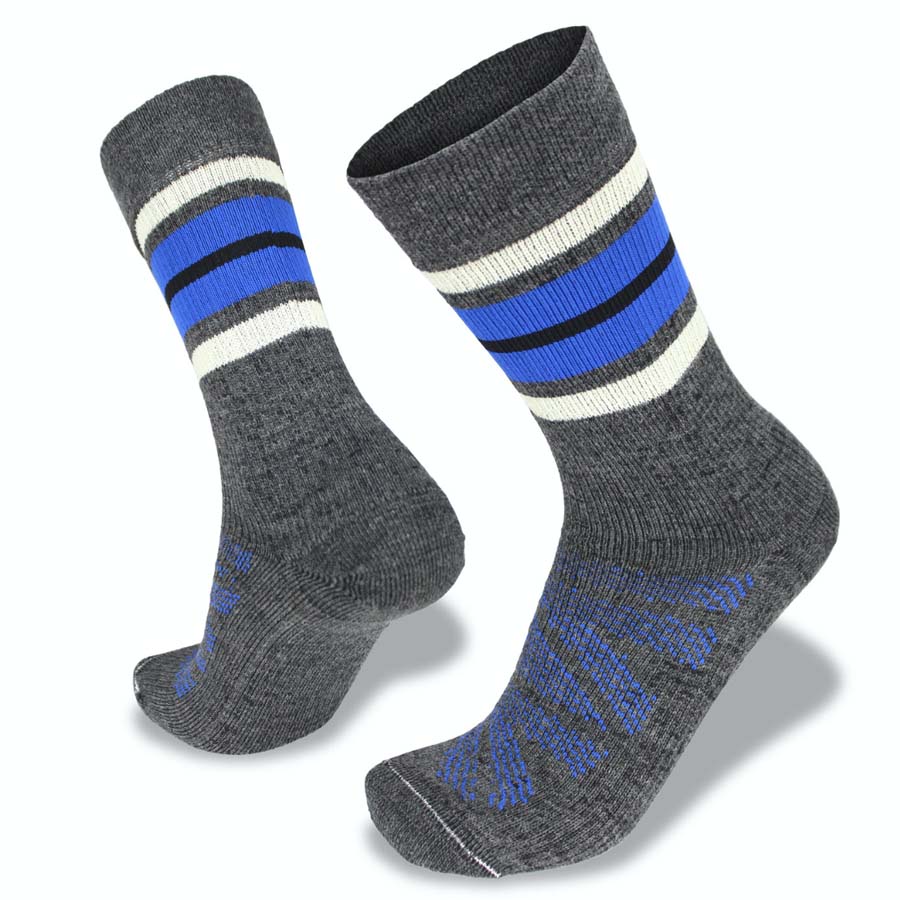
Wilderness Wear Men’s Velo Night Glow Socks – 1/2 height sock
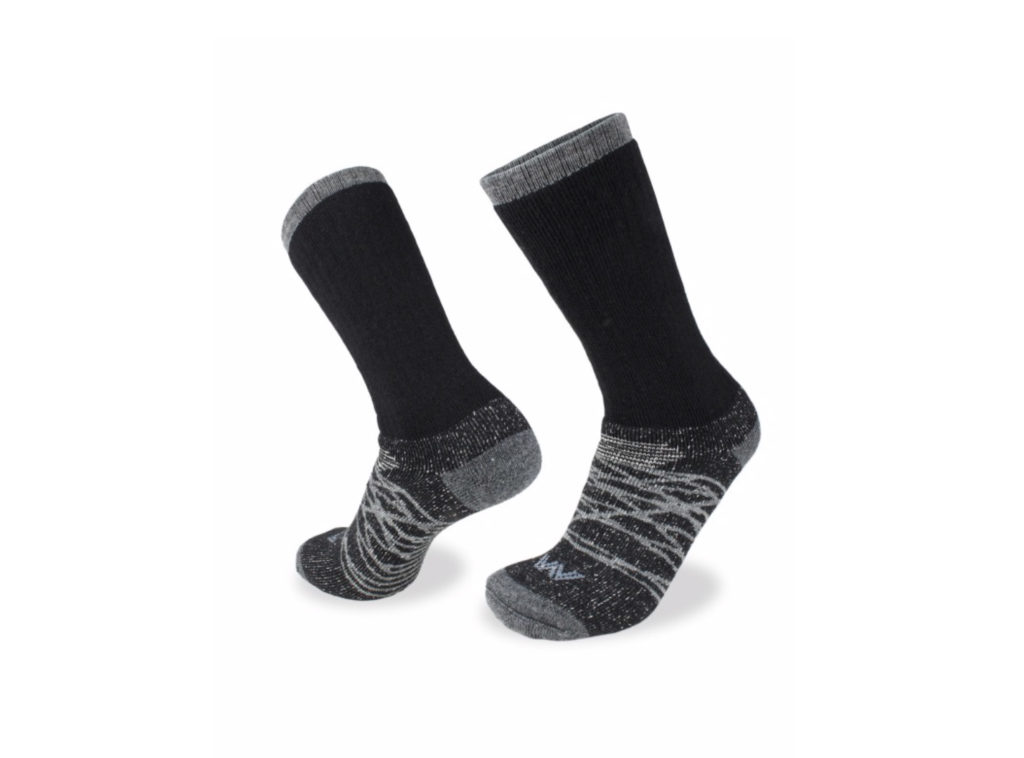
Wilderness Wear Larapinta Hiker socks – 3/4 Height
Cushioning
The cushioning a sock provides will influence the comfort underneath your feet as well as impacting the warmth. When looking at sock cushioning you need to do so in conjunction with the cushioning provided by your footwear. If your footwear is hard underfoot or has a ridged construction like many boots, you will often need to go for a sock that has greater cushioning. If you are using a trail runner for your hiking adventures heavy cushioning may not be required. While I use one particular model of sock for much of the year with my trail runners, when I occasionally switch to a boot I wear different sock options to suit the colder harsher conditions.
- No cushioning: This level of cushioning best describes lightweight running socks or sock liners. The socks are essentially a thin layer of material that provides not discernible cushioning. The warmth of the socks is only going to be suitable for warm conditions
- Light cushioning: These socks are a level about the no cushion option and again rely on your footwear to provide much of the cushioning. Often this sock will have much of the cushioning on the heels and toes but not much else. The warmth provided by the sock is also minimal
- Medium cushioning: This is where most hiking socks start with the undersole providing a good layer of cushioning, again manly on the heels and toes where all the pressure is excepted on your feet. The warmth of the socks will suit hikers who don’t feel the cold for the majority of the year
- Heavy cushioning: Aimed at hikers who need lots of cushioning underfoot and typically like their warmth. These socks are often used in colder conditions as they usually provide a greater level of warmth than many less cushioned versions.
The heavier the cushioning, the warmer the sock will be. I find that on the rare occasion I am using a very heavy grade sock, my feet tend to ‘slide’ about so even though the thick cushioning is a bonus its rare I will use a heavily cushioned sock preferring a mid-cushion with a warmer upper section to provide the increased warmth.
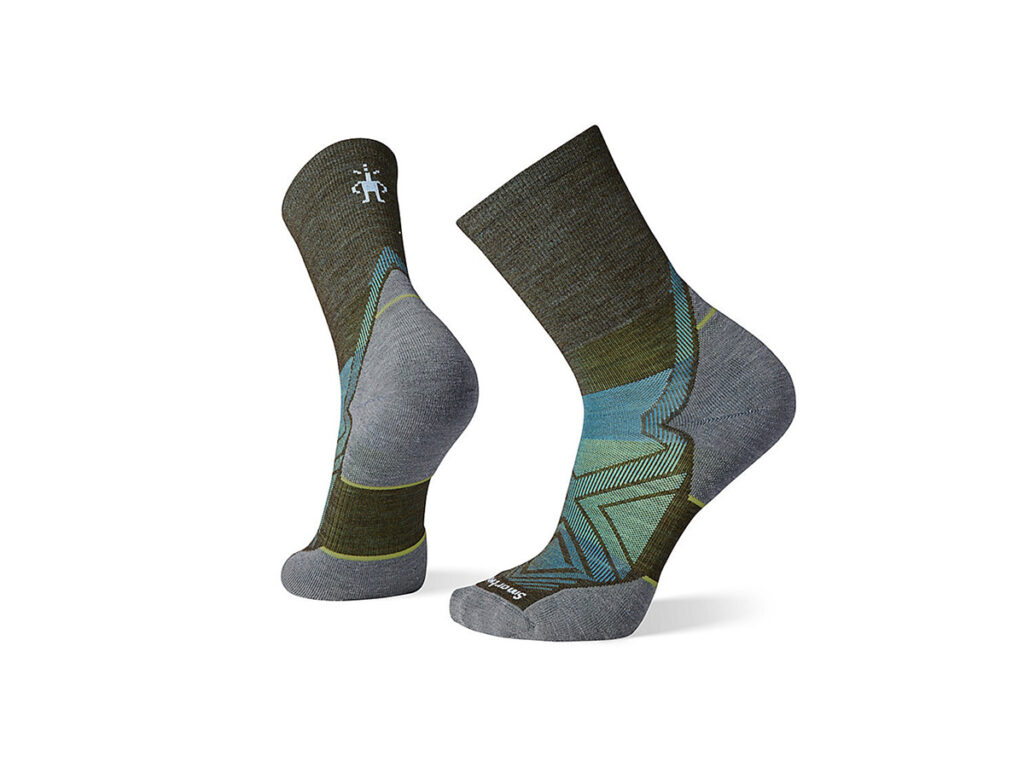
Smartwool Run Targeted Cushion Mid Crew Mens Socks. These socks are cushioned in just the right places and are my current sock of choice
Sock weight
When we talk about sock weight there are two things to consider; the physical weight and the thickness of the sock. The thickness of the sock will create a warmer sock and also provide a higher degree of cushioning as typically, thick socks tend to have a high degree of cushioning. This is just what you want in colder weather but the last thing you want in warm weather.
Longer socks by the sheer amount of material they have will weigh more but you can purchase long thin socks. Typically 3/4 or full length socks tend to be much thicker and heavier.
Material
I can remember many years ago wearing 100% wool socks and in those days they were a low quality wool and really scratchy. These days the manufacturing process and use of high quality natural and synthetic materials means that you now have a wide variety of standalone and hybrid materials to suit just about anyone’s needs. By combining various fabrics together its possible to create a sock that provides the appropriate level of warmth, dries quickly if it gets wet and is comfortable as well as being durable. The main materials you find these days are:
Natural materials
This includes wool, usually merino sheep’s wool. A good quality wool sock of the appropriate thickness will help to regulate temperature which minimises sweating, provides good cushioning, minimises odour and will keep you warm, to a degree, even if they get wet. Wool socks are also extremely comfortable, more so than synthetics socks. Wool socks, particularly the high quality ones, tend to be more expensive.
Synthetic
Socks that are synthetic have the advantage they dry very quickly when wet. Synthetic socks will typically breathe better than their woollen cousins so they tend to be excellent on hot days. Unfortunately though I have found over the years that when I walk through creeks and streams, they don’t tend to hold their shape well.
Blends
Most socks tend to be a blend of mainly wool with some synthetic material. This provides the best of both worlds and they will typically contain around 75-80% wool with the rest made up of synthetic fibre.
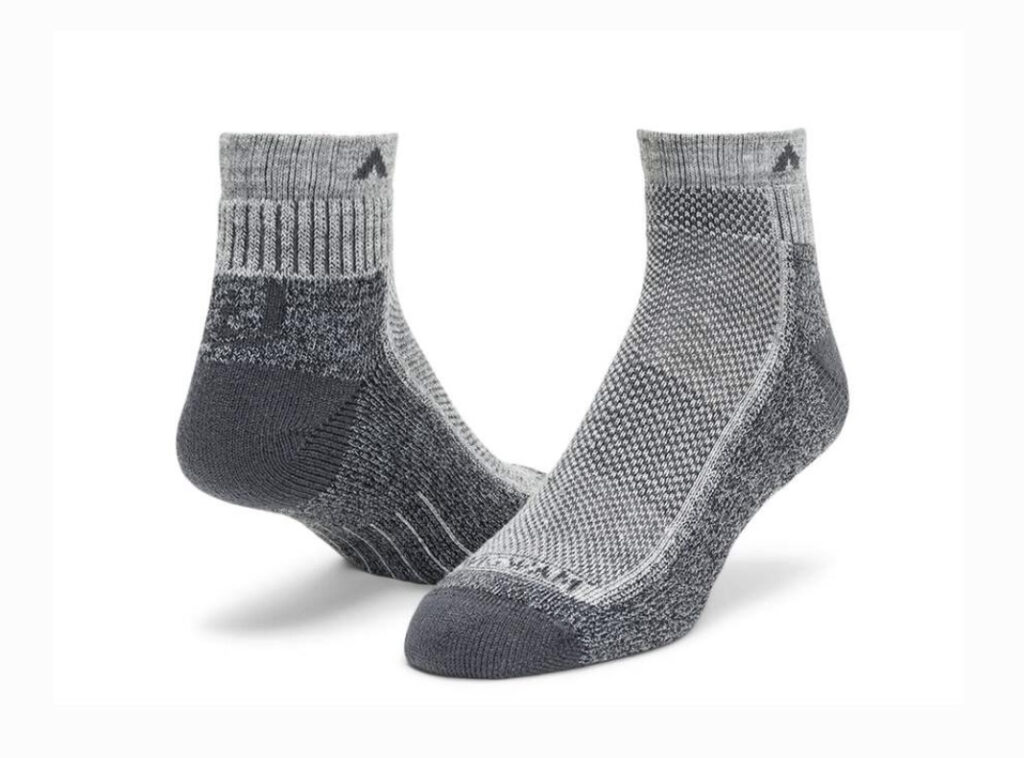
Wigwam Cool Lite Hiker Quarter Unisex Socks Grey Charcoal (synthetic sock)
Patterns and colours
While the pattern and colours you choose for your socks are very much a very personal thing and you think would have minimal bearing on sock choice, it can do. This isn’t to say that patterns and colours are important because what I look like really doesn’t matter one way or another.
What is important is that sometimes in the production of very complex patterns you may end up with lots of loose threading on the inside of the sock and this cause cause irritation or impact on the durability and performance of a sock. Even the more complex patterns used in hiking socks are typically on the more muted side when compared to many of the fancy patterns used in dress socks. Where possible, choose a sock that doesn’t have loose threads on the inside.
Odds and sods
Then there’s the odd sock type or style that’s just that little bit different. Theses include:
- Compression socks
- Many people will know this type of sock even if they haven’t used it. Favoured by long distance runners and for use on long distance flights but not very commonly used by hikers
- Sock liners
- While these socks can be used as a standalone they are definitely too thin for most hikers lacking in both warmth and cushioning. Their main use is a two layer sock system with the liner being used to absorb excess moisture away from your skin while leaving the main sock dry which will help minimise blister formation
- Lefties and righties
- As the name suggest these socks are specifically designed for the left and right foot providing the ultimate fit over a standard sock which is designed to suit either foot. Why then aren’t these socks more common? There is nothing worse than getting up in the dark and having to work out which sock goes on which foot. Yes I know that there are ways around this but I just find this concept not be very practical
- Toe socks
- Toe socks are another form of left and right footed socks but in this case provided your socks are not inside out its obvious which is the left sock and which is the right given you have five individual toes on each sock. The benefit of these socks is that they minimise moisture build up and friction between the toes which is the main cause of blisters while hiking. Because of the additional material in this type of sock, you need to ensure your shoe isn’t too narrow so keep that in mind. There are two type of hikers in the world, those that love toe socks and those that don’t!
- Double layer
- It’s not uncommon in socks built for snow conditions for them to come constructed with a built in liner creating two layers that perform exceptional well in very cold conditions. These sock are very much a snow sock and the few pairs I own of this type are used just for that.

Injinji Coolmax Liner Crew Unisex Toesocks
Last words
While socks are often low on the list of equipment priorities for hikers they are without a doubt one of the most important gear choices you can make. Over the years I have identified a range of socks that meet specific needs and while I regularly try different options, I aways come back to the tried and tested ones. For me this means a sock that is mainly wool, preferably Australian made, medium cushioning underfoot, lightweight material on the top of the foot and 1/4 length. In my case I don’t feel the cold that much and when doing big days, day in day out, I find this combination suits me well. I will use a heavy weight sock for snow conditions but even then it’s never the warmest sock you can find because I just overheat.
As previously mentioned socks are part of your ‘footwear system’ so when you are buying socks think about how they will work with your shoe/boot choice. When purchasing new footwear, wear your preferred socks to get a good indication of how they match.
One consideration I haven’t previously discussed is durability. I will typically walk around 3,000-4,000 km each year in my hiking shoes and while I will often wear through about four pairs of shoes a year to cover this distance, a good pair of hiking socks will easily last around 2,000 km and often more.
So next time you are are looking at footwear or are due for a new pair of socks, consider your feet and spend a bit of extra effort choosing the right socks.